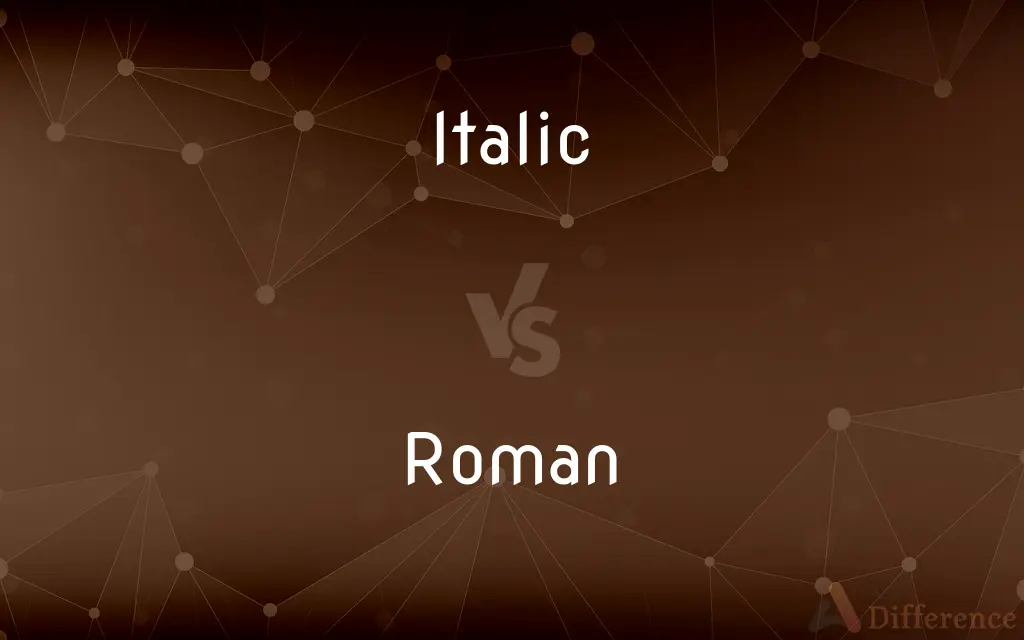Italic vs. Roman — What's the Difference?
By Maham Liaqat & Urooj Arif — Updated on March 26, 2024
Italic typefaces are slanted and often used for emphasis or distinction, while Roman typefaces are upright and standard for body text, reflecting stability and formality.

Difference Between Italic and Roman
Table of Contents
ADVERTISEMENT
Key Differences
Italic typefaces, characterized by their angled and often cursive appearance, are primarily used to emphasize parts of the text or to denote titles, foreign words, or thoughts. This style adds a dynamic and aesthetic element to the text, guiding the reader's attention to specific sections. On the other hand, Roman typefaces are upright, featuring a consistent and traditional structure that is easy to read, making them the default choice for the main body of text in various documents and publications.
While italic typefaces provide a sense of movement and emphasis, making text stand out on a page, Roman typefaces offer clarity and readability, ensuring that large blocks of text are easily navigable for the reader. The contrast between these two styles is often utilized in typography to create a visual hierarchy and to guide the reader’s eye through the content.
The origins of italic typefaces trace back to the Renaissance, inspired by calligraphic handwriting styles of that era, designed to mimic the fluidity and elegance of hand-written text. Conversely, Roman typefaces have roots in the inscriptions found in ancient Rome, embodying the principles of simplicity, durability, and authority. These historical backgrounds reflect the distinct aesthetic and functional purposes of each typeface in modern typography.
Italics are frequently used for quotes, annotations, or as a stylistic choice in various forms of writing, including both fiction and non-fiction. This usage enhances the text's visual appeal and can convey a different tone or mood. Roman typefaces, however, are favored for the main text due to their straightforwardness and legibility, making them indispensable for conveying clear and unambiguous information.
In the digital age, the distinction between italic and Roman typefaces has evolved, with italics playing a crucial role in web design and digital content to indicate hyperlinks, emphasize keywords, and improve user experience. Meanwhile, Roman typefaces continue to dominate the digital text for content readability and user accessibility.
ADVERTISEMENT
Comparison Chart
Orientation
Slanted
Upright
Usage
Emphasis, titles, foreign words
Main body text
Visual Impact
Dynamic, aesthetic
Stable, formal
Historical Origin
Renaissance handwriting styles
Ancient Roman inscriptions
Functional Purpose
Attract attention, convey mood
Ensure readability, convey information
Compare with Definitions
Italic
A font style where letters slant to the right, used for emphasis.
Italicized text often denotes book titles or emphasized words.
Roman
Used universally for body text in publishing.
Newspapers rely on Roman typefaces for legibility.
Italic
Used to highlight thoughts in narrative writing.
She thought, Maybe he's right.
Roman
Represents the default font style in word processors.
Word documents start with a Roman typeface setting.
Italic
Characterized by a stylized, elegant appearance.
Using italics can add a sophisticated flair to invitations.
Roman
Symbolizes traditional and formal text presentation.
Legal documents typically use a Roman typeface.
Italic
Signifies foreign words within English text.
The Italian word gelato means ice cream.
Roman
Emphasizes stability and readability in typography.
Academic papers benefit from the use of Roman typefaces.
Italic
Applied for differentiation in scientific names.
The scientific name Homo sapiens is always italicized.
Roman
The standard printing typeface with upright letters.
Most books are printed using Roman typefaces for clarity.
Italic
Relating to or denoting the branch of Indo-European languages that includes Latin, Oscan, Umbrian, and the Romance languages.
Roman
A narrative poem or a prose tale in medieval French literature.
Italic
The Italic group of languages.
Roman
A novel.
Italic
Of or relating to ancient Italy or its peoples or cultures.
Roman
A native, inhabitant, or citizen of ancient or modern Rome.
Italic
Of or relating to the branch of the Indo-European language family that includes Latin, Faliscan, Oscan, Umbrian, and the Romance languages.
Roman
The Italian language as spoken in Rome.
Italic
Italic Of or being a style of printing type patterned on a Renaissance script with the letters slanting to the right
This sentence is printed in italic type.
Roman
One belonging to the Roman Catholic Church.
Italic
The Italic branch of Indo-European.
Roman
Roman Roman print or typestyle.
Italic
Often italics Italic print or typeface.
Roman
Romans (used with a sing. verb) See Table at Bible.
Italic
Designed to resemble a handwriting style developed in Italy in the 16th century.
Roman
Of or relating to ancient or modern Rome or its people or culture.
Italic
Having letters that slant or lean to the right; oblique.
The text was impossible to read: every other word was underlined or in a bold or italic font.
Roman
Of or relating to the Roman Empire.
Italic
(typography) A typeface in which the letters slant to the right.
Roman
Of, relating to, or composed in the Latin language.
Italic
An oblique handwriting style, such as used by Italian calligraphers of the Renaissance.
Roman
Of or using the Latin alphabet.
Italic
Relating to Italy or to its people.
Roman
Of or relating to the Roman Catholic Church.
Italic
Applied especially to a kind of type in which the letters do not stand upright, but slope toward the right; - so called because dedicated to the States of Italy by the inventor, Aldus Manutius, about the year 1500.
Roman
Of or being an architectural style developed by the ancient Romans and characterized by the round arch as chief structural element, the vault, concrete masonry construction, and classical ornamentation.
Italic
A style of handwriting with the letters slanting to the right
Roman
Roman Of or being a typestyle characterized by upright letters having serifs and vertical lines thicker than horizontal lines.
Italic
A branch of the Indo-European languages of which Latin is the chief representative
Roman
Upright, as opposed to italic.
Italic
A typeface with letters slanting upward to the right
Roman
Of or related to the Latin alphabet.
Italic
Characterized by slanting characters;
Italic characters
Roman
(typography) One of the main three types used for the Latin alphabet (the others being italics and blackletter), in which the ascenders are mostly straight.
Italic
Of or relating to the Italic languages;
Ancient Italic dialects
Roman
(archaic) A novel.
Roman
Of or pertaining to Rome, or the Roman people; like or characteristic of Rome, the Roman people, or things done by Romans; as, Roman fortitude; a Roman aqueduct; Roman art.
Roman
Of or pertaining to the Roman Catholic religion; professing that religion.
Roman
Upright; erect; - said of the letters or kind of type ordinarily used, as distinguished from Italic characters.
Roman
A native, or permanent resident, of Rome; a citizen of Rome, or one upon whom certain rights and privileges of a Roman citizen were conferred.
Roman
Roman type, letters, or print, collectively; - in distinction from Italics.
Roman
A resident of modern Rome
Roman
An inhabitant of the ancient Roman Empire
Roman
A typeface used in ancient Roman inscriptions
Roman
Relating to or characteristic of people of Rome;
Roman virtues
His Roman bearing in adversity
A Roman nose
Roman
Of or relating to or characteristic of Rome (especially ancient Rome);
Roman architecture
The old Roman wall
Roman
Characteristic of the modern type that most directly represents the type used in ancient Roman inscriptions
Roman
Of or relating to or supporting Romanism;
The Roman Catholic Church
Common Curiosities
What is the main purpose of italic typefaces?
To provide emphasis, distinction, and aesthetic appeal in written text.
How do italic typefaces differ visually from Roman typefaces?
Italics are slanted and often cursive, adding dynamism, whereas Roman typefaces are upright and stable.
What is the historical origin of italic typefaces?
Inspired by Renaissance calligraphy, intended to mimic elegant handwriting.
Why are Roman typefaces preferred for body text?
For their clarity, readability, and formal appearance, making them ideal for conveying clear information.
Can italic and Roman typefaces be used together?
Yes, combining them effectively creates visual hierarchy and emphasis in text.
What roles do Roman typefaces play in digital content?
They ensure content is legible and accessible, maintaining readability across digital platforms.
Is there a difference in readability between italic and Roman typefaces?
Yes, Roman typefaces are generally more readable, especially for longer texts, while italics are used sparingly for emphasis.
Are italic typefaces considered less formal than Roman?
Italic typefaces can be both formal and informal, depending on their use and the overall design context.
What are the benefits of using Roman typefaces in academic writing?
They offer a standard, unambiguous presentation that is conducive to the clear communication of complex ideas.
What guidelines should be followed when combining italic and Roman typefaces in a document?
Maintain a balance between the two for clear hierarchy and emphasis, using italics sparingly for specific purposes while relying on Roman for the bulk of the text.
How do designers decide when to use italic or Roman typefaces?
Based on the need for emphasis, stylistic choices, and ensuring the text is engaging yet readable.
Why were Roman typefaces developed?
To create a clear, durable, and authoritative script that reflected the qualities of ancient Roman culture and architecture.
Can using too many italicized words affect readability?
Yes, overuse of italics can make text harder to read and dilute the emphasis intended for key points.
How do italic typefaces convey mood or tone?
Through their stylistic flair and dynamic appearance, italic typefaces can suggest movement, emotion, or emphasis, contributing to the tone of the text.
Share Your Discovery

Previous Comparison
Moco vs. Momo
Next Comparison
Negotiation vs. AssignmentAuthor Spotlight
Written by
Maham LiaqatCo-written by
Urooj ArifUrooj is a skilled content writer at Ask Difference, known for her exceptional ability to simplify complex topics into engaging and informative content. With a passion for research and a flair for clear, concise writing, she consistently delivers articles that resonate with our diverse audience.














































